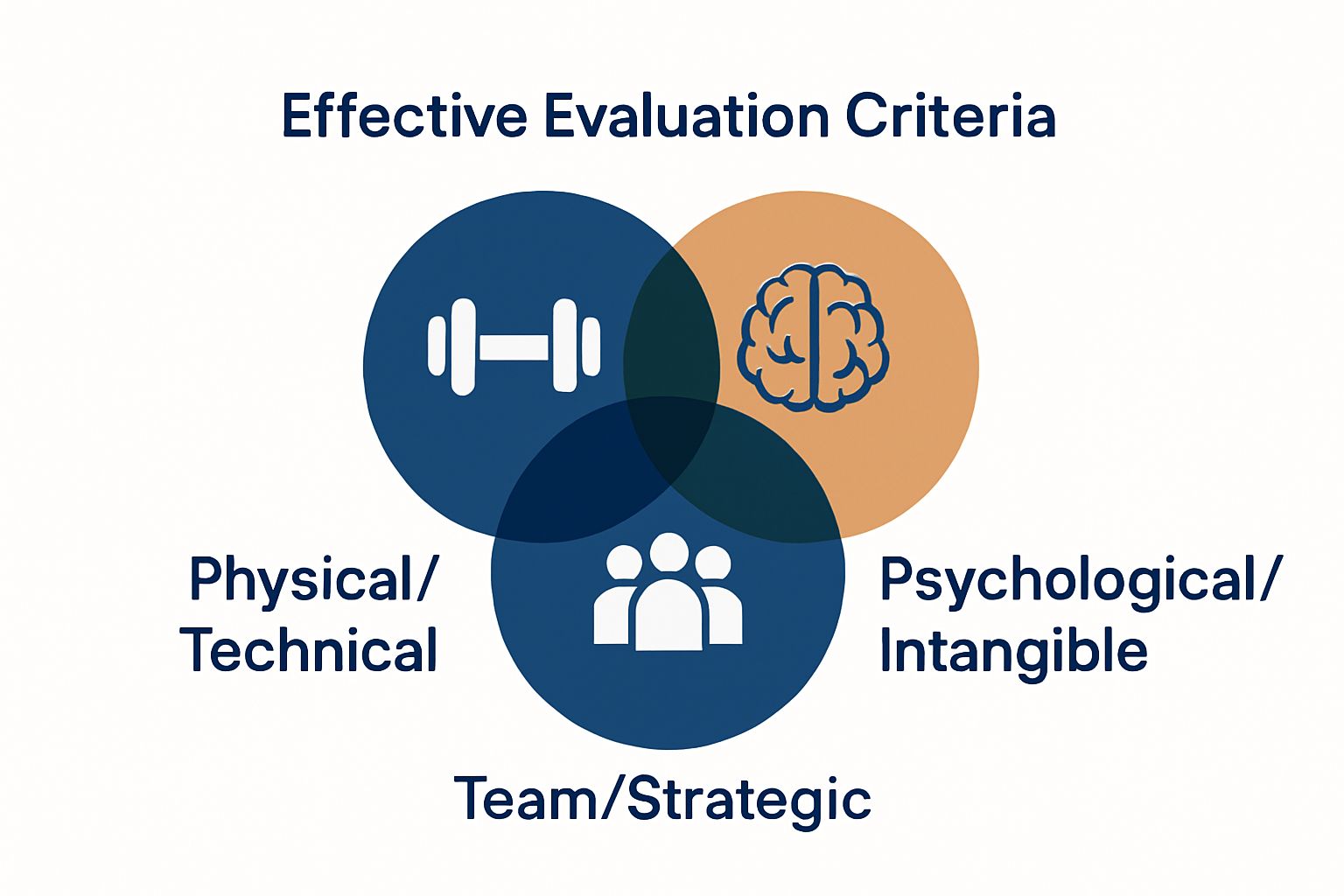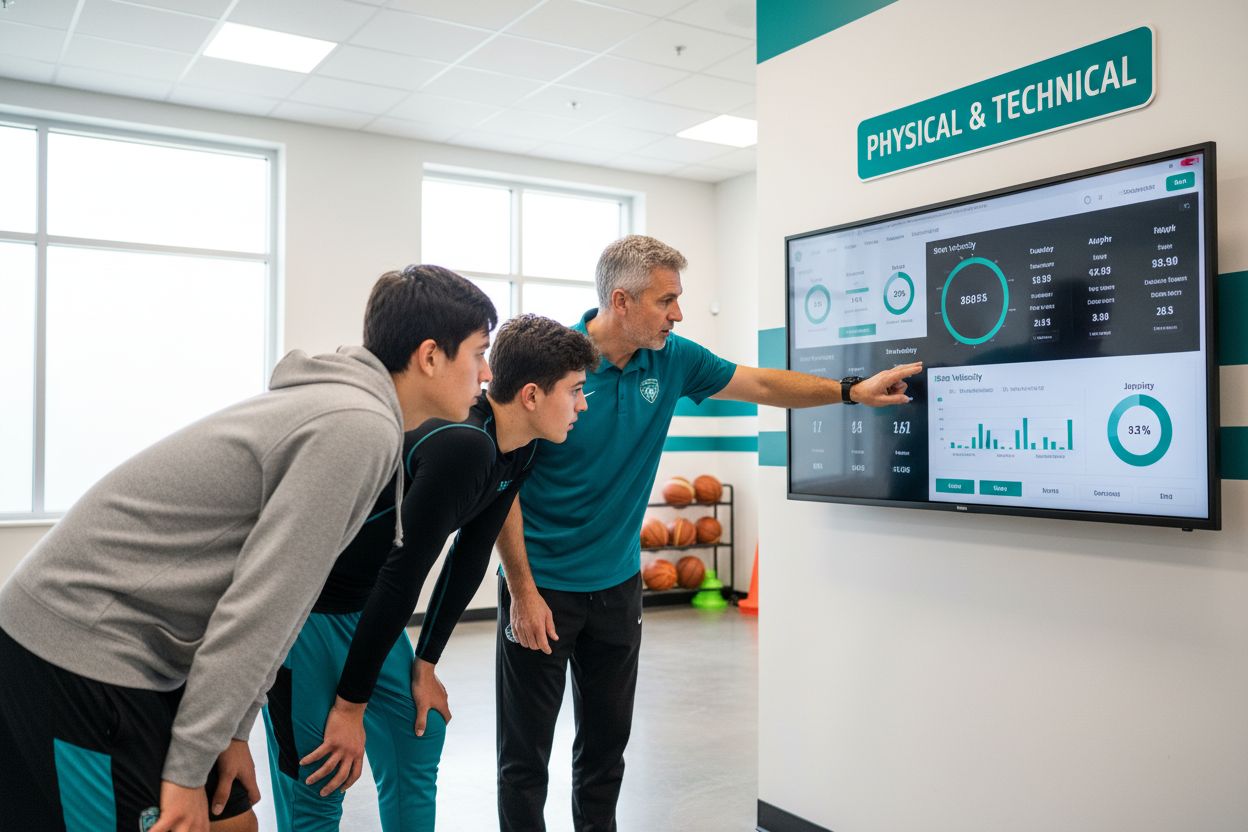Evaluating basketball talent used to mean just counting points and rebounds. Sounds simple, right? But new research shows that top coaches now combine stats and detailed observations to build a complete picture of every player. In fact, study-backed methods reveal players with high court awareness can impact a team’s success as much as raw scoring numbers. The best part is that these techniques are uncovering hidden gems once missed by traditional scouting.
Table of Contents
- Defining Basketball Evaluation Criteria: Key Concepts
- The Importance of Basketball Evaluation in Coaching
- Components of Effective Player Evaluation Criteria
- Implementing Basketball Evaluation in Real-World Settings
Quick Summary
| Takeaway | Explanation |
|---|---|
| Holistic evaluation improves performance | Combining quantitative data with qualitative insights leads to better player assessment and development. |
| Focus on player psychology | Assess mental resilience and emotional intelligence as crucial factors in player potential and team dynamics. |
| Use advanced technology for assessment | Implement tracking systems and video analysis to enhance evaluation accuracy and effectiveness. |
| Range of evaluation criteria is essential | Include physical skills, technical abilities, mental strategies, and intangibles in the player evaluation process. |
| Adapt evaluation frameworks to teams | Create flexible evaluation systems that adjust to individual player characteristics and team contexts. |
Defining Basketball Evaluation Criteria: Key Concepts
Basketball evaluation criteria represent a comprehensive approach coaches use to systematically assess player and team performance beyond simple statistical measurements. Research from academic sports performance studies indicates that effective evaluation methods blend quantitative data with qualitative observations to provide a holistic understanding of athletic potential.
Performance Measurement Framework
The foundation of basketball evaluation criteria involves understanding multiple dimensions of player assessment. Coaches must consider both measurable metrics and intangible qualities that contribute to team success. These evaluation dimensions typically include:
To clarify how coaches systematically evaluate basketball talent, the table below breaks down the main evaluation components, their focus, and brief descriptions.
| Evaluation Component | Focus Area | Description |
|---|---|---|
| Physical Athletic Capabilities | Speed, strength, endurance | Assesses an athlete’s physical fitness and conditioning |
| Technical Skill Proficiency | Shooting, defense, agility | Examines mastery of basketball-specific skills |
| Mental Game Understanding | Strategy, decision-making | Evaluates basketball IQ and tactical awareness |
| Team Interaction | Communication, leadership | Observes collaboration and leadership within the team |
| Psychological Resilience | Focus, emotional control | Measures ability to handle pressure and bounce back from setbacks |
- Physical athletic capabilities
- Technical skill proficiency
- Mental game and strategic understanding
- Team interaction and leadership potential
- Competitive attitude and psychological resilience
Successful evaluation requires a nuanced approach that goes beyond basic statistical tracking. Coaches analyze player performance through comprehensive lenses that capture not just what happens during gameplay, but how and why specific actions occur. This multifaceted perspective allows for more accurate player development strategies.
Qualitative and Quantitative Assessment Techniques
Modern basketball evaluation integrates advanced techniques that combine data analytics with subjective coaching insights. Quantitative methods involve precise statistical tracking of performance indicators like shooting percentages, defensive stops, assists, and overall court efficiency. Qualitative assessment focuses on harder-to-measure aspects such as court awareness, decision making speed, and emotional composure under pressure.
Coaches looking to enhance their evaluation process can explore our guide on basketball scouting techniques to develop more robust assessment frameworks. By understanding these key evaluation criteria, coaches can make more informed decisions about player development, team composition, and strategic gameplay.
This table highlights the differences between quantitative and qualitative assessment techniques in basketball evaluation, summarizing their key characteristics and examples.
| Technique Type | Main Focus | Key Characteristics | Common Examples |
|---|---|---|---|
| Quantitative | Measurable statistics | Data-driven, objective, reproducible | Shooting percentages, assists |
| Qualitative | Behavioral observation | Subjective, nuanced, context-dependent | Court awareness, leadership |
The Importance of Basketball Evaluation in Coaching
Basketball evaluation represents a critical strategic tool that transforms raw athletic potential into structured team performance. Contemporary sports psychology research demonstrates that systematic evaluation methods significantly enhance coaching effectiveness by providing objective insights into individual and collective player capabilities.
Strategic Performance Development
Effective basketball evaluation goes far beyond simple performance tracking. It serves as a comprehensive mechanism for understanding player dynamics, identifying strengths, addressing weaknesses, and creating targeted development strategies. Coaches who implement rigorous evaluation processes can:
- Customize individual training programs
- Optimize team composition and strategy
- Predict potential player growth trajectories
- Minimize performance limitations
- Create data driven decision making frameworks
The fundamental purpose of basketball evaluation is not just measurement, but transformation. By analyzing detailed performance metrics, coaches can design interventions that systematically improve player skills and team cohesion.
Holistic Player and Team Understanding
Comprehensive basketball evaluation provides coaches with a multilayered understanding of athletic potential. This approach transcends traditional statistical analysis by integrating physical, psychological, and tactical dimensions of player performance. Modern coaching requires a nuanced perspective that recognizes players as complex athletes with interconnected skill sets.
Coaches interested in developing more advanced evaluation techniques can explore our guide on developing leadership skills to enhance their coaching strategies. By embracing systematic evaluation methods, coaches can unlock unprecedented levels of team performance and individual player development.
Components of Effective Player Evaluation Criteria
Comprehensive basketball performance research reveals that effective player evaluation transcends basic statistical measurements, requiring a sophisticated approach that integrates multiple performance dimensions. Coaches must develop a nuanced framework that captures the complex nature of athletic potential and team dynamics.

Physical and Technical Performance Metrics
The foundational layer of player evaluation centers on measurable athletic capabilities. These objective metrics provide concrete insights into a player’s current performance level and potential for growth. Key physical and technical components include:
- Speed and acceleration
- Strength and endurance
- Shooting accuracy
- Defensive capabilities
- Agility and body control
- Technical skill precision
Successful evaluation requires coaches to understand that these metrics are interconnected. A player’s physical capabilities directly influence their technical performance, making holistic assessment crucial for comprehensive player development.

Psychological and Intangible Evaluation Factors
Beyond physical measurements, effective player evaluation must incorporate psychological and intangible qualities that distinguish exceptional athletes. These less quantifiable elements often determine a player’s true potential and team compatibility. Coaches analyze aspects such as leadership potential, mental resilience, strategic understanding, and emotional intelligence.
Coaches looking to streamline their evaluation process can explore our comprehensive basketball player evaluation form to capture these nuanced performance dimensions. By developing a multifaceted evaluation approach, coaches can create more targeted development strategies that unlock each player’s unique potential.
Implementing Basketball Evaluation in Real-World Settings
Practical sports performance research demonstrates that successful basketball evaluation requires strategic implementation that bridges theoretical frameworks with practical coaching techniques. Coaches must develop flexible approaches that adapt to individual team dynamics and player characteristics.
Systematic Evaluation Process Design
Creating an effective evaluation framework demands a structured yet dynamic methodology. Coaches need to establish clear protocols that allow for consistent yet personalized assessment. This involves developing comprehensive observation systems that capture multiple performance dimensions:
- Standardized performance tracking metrics
- Periodic skill progression assessments
- Qualitative observation protocols
- Individual player development benchmarks
- Team performance integration strategies
The key to successful implementation lies in creating flexible systems that provide actionable insights. Evaluation methods must remain adaptable, allowing coaches to modify approaches based on emerging player capabilities and team requirements.
Technology and Data Integration
Modern basketball evaluation increasingly relies on technological tools that enhance traditional observation methods. Advanced tracking systems, video analysis software, and performance analytics platforms enable coaches to collect precise data and generate nuanced player insights. These technologies transform subjective assessments into objective, measurable performance evaluations.
Coaches seeking to enhance their strategic approaches can explore our comprehensive basketball playbook resources to develop more sophisticated evaluation techniques. By combining technological tools with experienced coaching perspectives, teams can create robust performance assessment strategies that maximize player potential and team effectiveness.
Ready to Upgrade Your Player Evaluation Process?
When it comes to truly understanding and measuring basketball performance, coaches face the tough challenge of capturing both statistics and those crucial intangibles highlighted in our article. Many struggle to move from basic observation to building a real, actionable system for player assessment. These gaps can delay player growth and slow down team progress. If you are searching for an easier way to implement effective, data-driven evaluation methods, explore our Basketball Templates. Here, you will find ready-made forms and tools tailored to cover all the physical, mental, and leadership qualities discussed above.

Let Hoop Mentality help you simplify your entire coaching workflow so you can focus on developing winning teams, not paperwork. Visit Hoop Mentality today to see how our professional resources can elevate your evaluations and boost your team’s success this season. Action taken now will set your season apart from the rest.
Frequently Asked Questions
What are the key components of basketball evaluation criteria?
The key components of basketball evaluation criteria include physical athletic capabilities, technical skill proficiency, mental game understanding, team interaction, and psychological resilience.
How can coaches integrate qualitative and quantitative assessment techniques?
Coaches can integrate qualitative techniques, such as observing court awareness and decision-making, with quantitative methods by tracking performance statistics like shooting percentages and defensive stops.
Why is basketball evaluation important for coaches?
Basketball evaluation is crucial for coaches as it helps transform athletic potential into structured performance, allowing for customized training programs and better team strategy.
What role does technology play in basketball evaluation?
Technology enhances basketball evaluation by providing advanced tracking systems and performance analytics platforms that turn subjective observations into objective, measurable data.

